#Algae Control in Ponds
Explore tagged Tumblr posts
Text
Best Blanketweed Treatment
Discover the best blanketweed treatment you can buy for controlling blanketweed in your pond. Learn effective methods to manage this common algae, including tips for reducing nutrient levels, choosing safe treatments like Aqua Source Blanketweed Resolve, and maintaining a healthy pond ecosystem.
What is Blanketweed? Blanketweed, also known as filamentous algae or string algae, is a common nuisance in ponds and aquariums. This fibrous algae forms dense mats of green or brown strands, giving the water a tangled, unattractive appearance. Often resembling a blanket spread across the water’s surface, blanketweed can quickly overwhelm ponds, especially those with excess nutrients and sunlight…
#Algae Control in Ponds#Aqua Source Blanketweed Resolve#Blanketweed Solutions#Blanketweed Treatment#Filamentous Algae#Natural Pond Care#Pond Algae Control#pond maintenance tips#String Algae Removal
0 notes
Text
Advanced UV-C LED Ultraviolet Water Purification Technologies | PUROXI
Discover PUROXI’s innovative UV-C LED ultraviolet technologies for water purification. These cutting-edge systems use powerful UV-C light to effectively eliminate harmful bacteria, viruses, and other contaminants, ensuring safe, clean water. Ideal for residential, commercial, and industrial applications, PUROXI's UV-C solutions are designed to provide long-lasting, energy-efficient, and eco-friendly water treatment. Learn more about how our UV-C LED technology can enhance your water quality and safety.
0 notes
Text
Algae Control in Ponds: A Guide to a Pristine Water Garden

View On WordPress
#2023#algae#algae control#algae control products#aquascaping#beneficial bacteria#blog#learning#maintenance#meyer aquascapes#new#plants#Pond Tips#tips
0 notes
Text
Pairing frogs and toads together might conjure memories of Arnold Lobel’s beloved characters — dressed to the nines in caramel coats and polyester — biking off toward adventure.
But in the animal world, frogs and toads on nearly every continent are facing a much more harrowing adventure: a decades-long fight against a mysterious fungal virus that has afflicted over 500 amphibian species.
Since the 1990s, scientists estimate that the chytridiomycosis disease caused by the fungal pathogen Bd (Batrachochytrium dendrobatidis) has led to the extinction of 90 amphibians. One of the lost species includes the Panamanian golden frog, which hasn’t been spotted in the wild since 2009.
Fortunately, a new research study has finally pinpointed the virus that has been infecting fungal genomes for decades.
“Bd is a generalist pathogen and is associated with the decline of over 500 amphibian species…here, we describe the discovery of a novel DNA mycovirus of Bd,” wrote Mark Yacoub — the lead author of the study and a microbiology doctoral student at the University of California, Riverside.
In an interview with UC Riverside News, Yacoub said that he and microbiology professor Jason Stajich observed the viral genome while studying the broader population genetics of mycovirus (viruses of fungi).
The discovery will undoubtedly have monumental impacts on future amphibian conservation efforts. This includes the possible launching of new research studies into fungal species strains, the practice of cloning and observing spores, and engineering a solution to the virus.
But Yacoub cautioned that this is only the beginning.
“We don’t know how the virus infects the fungus, how it gets into the cells,” Yacoub said. “If we’re going to engineer the virus to help amphibians, we need answers to questions like these.”
Still, as scientists strengthen conservation efforts to save frogs and toads (and salamanders too!) they also appear to be saving themselves. Yacoub pointed out several amphibian species around the world have begun exhibiting resistance to Bd.
“Like with COVID, there is a slow buildup of immunity,” Yacoub explained. “We are hoping to assist nature in taking its course.”
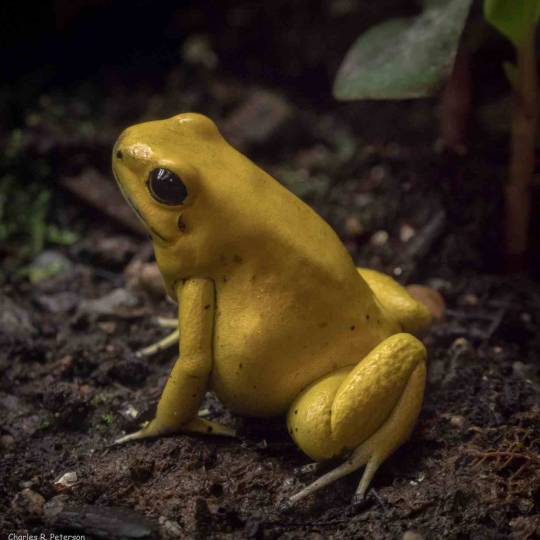
Pictured: A Golden poison frog — one of the many species endangered by chytridiomycosis — in captivity.
Why are frogs and toads so important?
From the get go, every amphibian species plays an important role in their local ecosystem. Not only are they prey for a slew of animals like lizards, snakes, otters, birds, and more, but in an eat-or-be-eaten world, frogs and toads benefit the food chain by doing both.
Even freshly hatched tadpoles — no bigger than a button — can reduce contamination in their surrounding pond water by nibbling on algae blooms.
As they grow bigger (and leggier), amphibians snack on whatever insect comes their way, greatly reducing the population of harmful pests and making a considerable dent in the transmission malaria, dengue, and Zika fever by eating mosquito larvae.
“Frogs control bad insects, crop pests, and mosquitoes,” Yacoub said. “If their populations all over the world collapse, it could be devastating.”
Yacoub also pointed out that amphibians are the “canary in the coal mine of climate change,” because they are an indicator species. Frogs and toads have permeable skin, making them sensitive to changes in their environment, and they also rely on freshwater.
When amphibians vanish from an ecosystem, it’s a symptom of greater environmental issues...
Herpetologist Maureen Donnelly echoed Yacoub’s sentiments in an interview with Phys Org, noting that when it comes to food chains, biodiversity, and environmental impact, the role of frogs and toads should not be overlooked.
“Conservation must be a global team effort,” Donnelly said. “We are the stewards of the planet and are responsible for all living creatures.”
-via GoodGoodGood, April 22, 2024
#frog#frogs#toads#frogs and toads#conservation#biodiversity#herpetology#mycology#fungi#endangered species#extinction#ecosystems#climate change#environment#biology#environmental science#ecology#good news#hope#frogblr#frog blogging
352 notes
·
View notes
Text
A little chengzhan silly about Jiang Cheng cleaning Lan Wangji's pond that I wrote as a birthday annoyance for @haifoct last year.
A white robed duckling entered the Jingshi’s gardens. The junior Lan disciple had been quite disturbed by noises of heavy panting and cursing. The sight that presented itself now, however, left him more worried about Hanguang-Jun than expected.
Inside the small pond stretching between the house and a simple pavilion was a man, knee-deep in the water, bare chest gleaming with sweat in the summer sun. No other than the infamous Sandu Shengshou, Jiang Zongzhu was wading through the pond, ripping bundles of algae out of it and throwing them behind him where they landed with a squelching noise on the grass. A cascade of curses too violent for the Cloud Recesses escaped his foul mouth continuously.
The junior disciple clutched his sword to his chest, unsure if he should be concerned or afraid, even more unsure if he should draw his sword or stab himself awake. On the Jingshi’s sunlit porch sat Hanguang-Jun, legs crossed as if to meditate, a cup of tea cradled in his slender hands. An aura of complete calm and serenity veiling him into his own universe.
Keeping his distance to the cursing, half-naked man in the pond, the junior disciple made his way up the porch, all his skill needed to dodge the bundles of algae thrown about.
“Hanguang-Jun,” he said cautiously. “Should I alert the elders that Jiang Zongzhu is in need of an exorcism?”
“No need,” Hanguang-Jun replied, voice calm and eternally steady, teacup secured in his hand, his thumb rubbing strangely, almost distractedly along the rim.
The disciple felt a blush watching those usually controlled fingers move like this and quickly looked away, blushing even fiercer when Jiang Zongzhu tore a giant bulge of algae and weed out of the pond, ripping it over his head with a manic expression of victory that eclipsed any descriptions from blood painted war stories.
Jiang Zongzhu was a well-trained man, his body an example what almost four decades of dedicated training and cultivation could achieve. Lean muscle of his chest and shoulders revealed, wet pants barely holding onto his waist. If Hanguang-Jun were interested in such a physique, it might have been a challenge to face this indecent display of bare skin. And as his disciple, it would have been his duty to guard Hanguang-Jun’s eyes.
Alas, Hanguang-Jun walked on this world free of any desires. The sight of this bare-chested man did not faze him. His eyes keeping watch of every move should that man endanger himself in his rage, his posture straight and envious, unbothered by anything, his ears flushed from being exposed to the bright sun too long.
“Han-Hanguang-Jun,” the junior disciple said, incredibly weirded out despite knowing there was nothing to feel weird about with Hanguang-Jun and Jiang Zongzhu. “Why is Sandu Shengshou weeding your pond if he isn’t cursed?”
“Mn…” Hanguang-Jun ran his thumb along the edge of his teacup. “I do not know. I will keep a close eye to find out.” He tilted his head when Jiang Zongzhu dug into the pond, water splashing high in a fountain that showered his hair until it escaped the bun’s hold. Dark strands glued to his face and neck by water and sweat. Jiang Zongzhu threw himself forward like he wanted to dive into the water, bending low to growl angrily at a piece of weed refusing to be pulled out easily.
“Lan Wangji,” Jiang Zongzhu suddenly bellowed towards the heavens. “Learn to clean your damn pond! If I see this mess one more time, I drag you to Lotus Pier to show you how clear a lake can be!”
The junior disciple gasped at this insulting behaviour. Nothing was cleaner and better taken care of than Hanguang-Jun’s garden, after all.
He turned – and for the first time in his life, he saw the faintest flicker of a smile on Hanguang-Jun’s face. Quickly disappearing behind the cup when he took a sip of tea. A long sip. Even his throat was now as red as his ears.
Whatever this was, the junior disciple decided to leave it alone and attempt to forget about it. No one would believe him anyway.
#chengzhan#zhancheng#jiang cheng#lan wangji#duckling pov#jiang cheng helping lan wangji improve his pond cleaning routine#teacher jiang must explain again#wangji was distracted#🤭🤭🤭#we must indulge in chengzhan sillies at times
55 notes
·
View notes
Text
Fish of the Day
Today's fish of the day is the guppy, by special request of @guppiesareamazing !
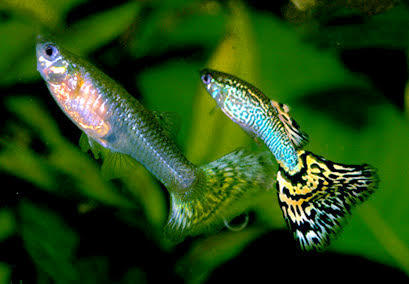
The guppy, also known as millions in some English dialects, and scientific name Poecilia reticulata, is a well known freshwater fish. Common across every continent but Antartica, the natural range of the guppy stretches across the warm and tropical waters of South America and the Caribbean, from as far North as Venezuela, far South as Bolivia, and stretching Pacific to Atlantic oceans. Living in smaller streams or ponds due to poor swimming skills in faster waters, these fish are known for their ability to withstand brackish and slightly salty freshwaters, with an ability to be acclimated to saltwater (similar to their close relatives, mollies). Although, saltwater guppies have far fewer offspring. These fish are benthic, living on the river bed, but require water temperatures around 23-24 °C to survive. They can live in any elevation, with some restriction on increased pressure, and due to their highly adaptable way, are incredibly common in the aquarium trade!
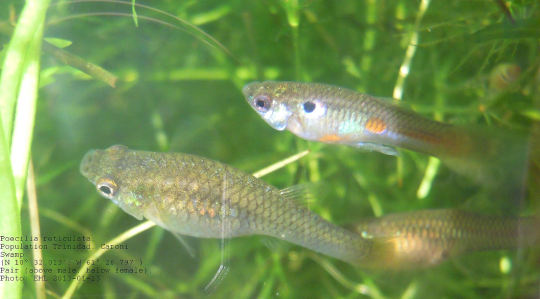
The reason for the widespread populations across the globe is due to their habit of eating mosquito larvae, meaning they were often intentionally imported in an effort to control malaria. Although current studies show this was ineffective at best as a control method. However, these populations have caused issues worldwide. Since they are highly adaptable, guppies tend to kill out local species, bringing both competition for food, and disease. In particular, guppies are known for carrying: a parasitic flatworm species known as Gyrodactylus turnbulli which causes the host to swim erratically before dying, waiting for other fish to feed on the corpse so it can infect another host. Along with fin rot, ich, swim bladder disease, and columnaris bacteria, all of which is infectious to other fishes. In the United States, guppies are known particularly for being a problem along the Southwest, and Southeast, driving out cyprinids and killifishes, and damaging damselfly populations.
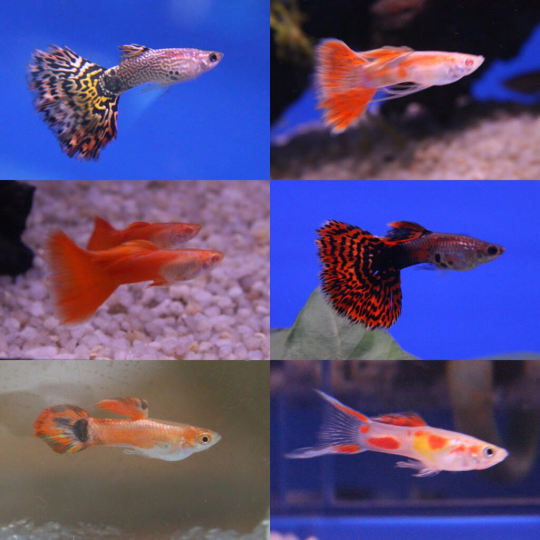
As discussed earlier, the diet of the guppy is made up of algae, zooplankton, insects/larvae, and surrounding detritus. Foraging for sustenance is common, and they travel in shaling groups as large as 30 individuals. These foraging groups help keep the fish calm, and spending less energy on anti predatory behaviours, leading to guppies that are less aggressive and less competitive, the same reason they need to be kept with multiple of their species in hobby tanks and captivity. In both wild and captivity, this fish is often predated on, especially considering they only grow to an adult size of 4-7cm in length.
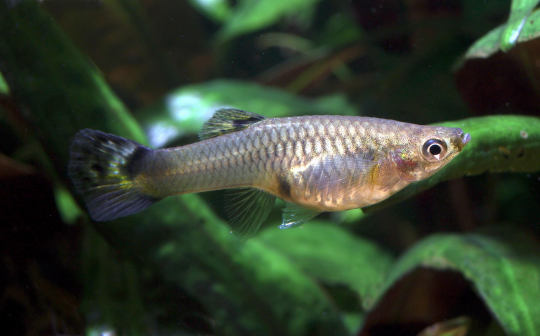
However, guppies have several tactics for avoiding predation. Considering the bright colors of male guppies, the schools help populations of guppies under high predations, as sholes band together to make antipredator decisions. In these groups, some guppies act as inspectors, approaching predators to assess the danger, and are thought to report back to the larger group, although research is still being conducted. Other tactics, such as the ability to darken the iris of the eyes from silver to black, draws predator attention toward the head of the animal, giving the fish an easier time pivoting out of the way of a strike than if the predator aims for the center of mass. All these abilities to avoid predators only aid the guppies ability to adapt to new areas, making them such an issue as an invasive species.
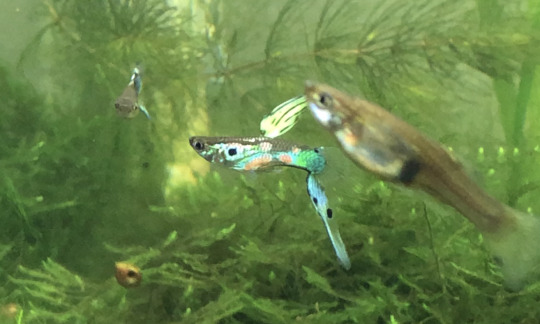
The lifecycle of the guppy is like that of many other small fish. There are two generations per year, as male fish mature at the ripe age of 2 months and females mature at 3 months, with maturity causing males to exhibit sexul dimorphism dependent on the amount of a certain thyroid hormone that influences color patterns, as female guppies are attracted to brighter colors. Many of these bright colored males are bred specifically for different bright and flashy colors in the freshwater trade, leading to the many different variants of them in the hobby aquarium market. Their total lifespan is only around 2 years, and most fish will survive to see 3 breeding seasons total throughout their lifespan.
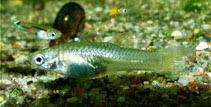
Female guppies give birth to live young, who can swim immediately and are often eaten by the parents soon after birth. In mating itself, females will take on multiple male mates a season, despite being incredibly picky about which they choose. This is thought to be in an effort to avoid inbreeding. Most of the choices that female fish make are based on the number and prevalence of orange spots on the flank and caudal tail of the fish. The orange spots are made up of a pigment that the guppies can not synthesize, and must be obtained in the diet. These spots show how healthy the male is, and is a good show for the presence of parasites. After a show of courtship behaviour and an acceptance, the female fish will gestate for 21-30 days, before giving birth to anywhere from 30-200 fry over the course of several hours. Although common, female guppies do not always eat their fry, and this can be prevented entirely by keeping the adult guppies happy and full of live prey, such as brine shrimp, well raising fry.
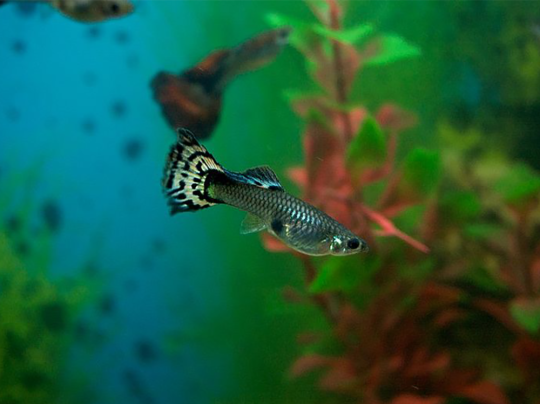
That's the guppy, everybody! Hope everyone has a wonderful day!

#guppy#guppies#Poecilia reticulata#fish#fish of the day#fishblr#fishposting#aquatic biology#marine biology#freshwater#freshwater fish#animal facts#animal#animals#fishes#informative#education#aquatic#aquatic life#nature#river#ocean#hobby tank#freshwater tank
33 notes
·
View notes
Text
I went to go do tashlich today and i set out bread and orthodox ashkenaz machzor in hand (the transliteration throwing me off as i flipped through), to walk to the nearest body of water, a small stream near the university chapel. It isn't really a chapel but i don't know the word to describe it. So i walk to head to the stream and as I grow closer to the stream there is a wedding, Mazel Tov i guess but i felt it would be odd to linger here so i set off elsewhere.
There was a larger pond near by but it was close to the buildings and i get self conscious davening around other people especially goyim. The other pond, was more secluded but it was the domain of the geese that i see travelling every morning to in military formation.
In the back of my mine i could hear the reprimand i had heard before about walking around in the woods on my own. (There are paths)
but then I remembered the pond! Not just any pond but one i had found in the middle of the woods somewhere.


So i wander about along the cleared paths of grass and dirt occasionally stumbling upon clearings where trees had been cut. I realize then as i quickly turn the other way that im really no different from the skittish rabbit that flees when i come near.
So i continue to wander marveling at the tall birch trees and the purple wildflowers and listen to the rustle of wind and the whine of insects that are too small to be seen but whose presence is heard. I enjoy nature. I get to witness creation. It leaves me in awe of G-D.
I had no clue where but i was determined to find it. I knew it existed i just had no clue where.
So i searched and searched and searched and almost decided to give up and return home. But i decided to try one more path. And soon i found my pond.

What caught me off guard was the colour of the water. I didn't recall the turbidity being that high.

Perhaps it was humans with chemicals that leach into the water or perhaps it was algae or plankton that has grown out of control either way it showed why Gevurah must balance Chesed.
I preform tashlich the beauty of G-D's creation in front of me. I become reminded of my hesitancy regarding my exploits
אדוני לי לא אירא, מה יעשה לי אדום
Adonai is with me, I will not fear, what can man do to me
As I cast my crumbs of bread into the waters I notice how strange it looks. Out of place. Far too human amongst the natural.
And I began to wonder if that was the point. It's supposed to be out of place. I am an environmental studies major and I have learned no matter how far you go there is very few areas that haven't been touched either with care or harm by humans. In the deepest oceans you will find plastic bags.
We hurt G-D's creation, we harm one another even though we too are part of His creation. Yet we go to the river and we cast our sins, as if we are, with heavy hearts, handing them back to Hashem by placing something so human back into the natural.
And Hashem forgives us, in turn we must strive to do better.
As humans and all life in general we can't eliminate our impacts on the world around us not necessarily good or bad but simply the result of being alive. Everything effects everything. It feels daunting. Especially when we need to repair so much.
But G-D forgives and G-D gives me hope and strength.
I'm an environmental studies and sustainability major so forgive me for my rambles.
4 notes
·
View notes
Text
youtube
Costa meets a gardener who has created a haven for frogs and gets his tips for pond design.
Sean is a garden landscaper and his own backyard is a 2.5-hectare block in the Noosa hinterland.
Here he has been able to explore his habitat hobby – building frog ponds. He has more than 50 here already and through his work reckons he has created about 600.
Sean has been creating habitat for wildlife since he was a young boy (he’d already built three by the time he was seven!) and he’s been learning about his current home environment and its flora and fauna for more than 20 years, transforming a barren horse paddock to a diverse paradise. He watches how the animals use the environment, then follows their lead to create better habitat for them.
He observed and followed the natural contours of the land to create water channels, adding mulch-like rocks and logs for extra habitat, and layers of plants, “because frogs exist in all the layers of vegetation, from trees to palms, grasses and groundcovers,” Sean explains. He has counted 17 different species of frog in his backyard.
Sean says that no matter what the type of pond or frog you want to cater for, in most climates you want the pond to receive a reasonable amount of sunlight but not too much. “Full sun will just lead to full on algae growth”
Cane toads don’t like moving through thick grass layers so he plants densely to try to keep these out.
To avoid breeding mosquitoes, Sean recommends installing a pump or waterfall to keep the water moving, but long-term he says you need patience to allow the natural ecosystem to build up, so predators will control their numbers.
Sean also grows lots of fruit and vegetables, keeping his family fed through the year, because he’s keen to show you can have both habitat and healthy food production.
Featured Frogs and Toads:
CANE TOAD - Rhinella marina
CASCADE TREE FROG - Litoria pearsoniana
GREEN TREE FROG - Litoria caerulea
EMERALD-SPOTTED TREE FROG - Litoria peronii
EASTERN SEDGEFROG - Litoria fallax
STRIPED MARSH FROG - Limnodynastes peronii
Featured Plants:
FLAX-LILY - Dianella sp.
CREEK MAT-RUSH - Lomandra hystrix
Filmed on Kabi Kabi Country | Pomona, Qld
#gardening australia#solarpunk#australia#frog#toad#frogs#toads#frogs and toads#habitat#frog habitat#gardening#garden#Youtube
5 notes
·
View notes
Text

Maximizing the Lifespan of Your Retention Pond with Proper Care
Retention ponds are essential tools in stormwater management, designed to control runoff, reduce flooding, and improve water quality. However, like any infrastructure, these ponds require proper care and maintenance to function effectively and last for years.
Neglecting their upkeep can lead to costly repairs, environmental damage, and reduced efficiency. Here’s how to maximize the lifespan of your retention pond through proper care and maintenance.
The Importance of Retention Pond Maintenance
Retention ponds are crucial in collecting and storing stormwater runoff from residential, commercial, and industrial areas. They help slow water flow, trap pollutants, and protect nearby ecosystems. Without regular maintenance, sediment buildup, overgrown vegetation, and debris accumulation can compromise the pond’s efficiency, reducing its capacity to handle heavy rainfall and increasing the risk of flooding.

By prioritizing proper care, you can extend the lifespan of your retention pond, ensuring it continues to serve its purpose effectively while maintaining compliance with local regulations.
Essential Maintenance Practices for Retention Ponds
1. Sediment Removal Over time, sediment accumulates at the bottom of retention ponds, reducing their water storage capacity. Periodic sediment removal ensures the pond retains its ability to manage stormwater effectively.
2. Vegetation Management Managing plant growth around and within the pond is essential. While some vegetation is beneficial for stabilizing soil and filtering pollutants, excessive growth can block water flow, damage structures, and create maintenance challenges.
3. Debris Cleaning Leaves, trash, and other debris can clog inlets, outlets, and other critical structures. Regular cleaning prevents blockages and ensures smooth water movement.
4. Bank Stabilization Erosion of the pond’s banks can compromise its structural integrity and contribute to sedimentation. Stabilizing the banks with riprap, natural vegetation, or other techniques helps prevent erosion and maintains the pond’s shape.
5. Outlet Structure Maintenance The outlet structure is vital for regulating water levels and flow. Regular inspections, cleaning, and repairs keep this component functioning properly and prevent overflow or stagnation.

Signs Your Retention Pond Needs Attention
Proper maintenance begins with recognizing when your retention pond needs care. Here are some signs to watch for:
Reduced Water Capacity: If the pond consistently overflows during heavy rains, sediment buildup may be limiting its capacity.
Visible Erosion: Eroded banks or shoreline areas indicate a need for stabilization efforts.
Excessive Vegetation or Algae Growth: Overgrowth or algal blooms can signal nutrient imbalances or lack of maintenance.
Clogged Inlets or Outlets: Blockages reduce water flow and can lead to flooding.
Unpleasant Odors: Stagnant water may indicate poor circulation or excessive debris.
The Role of Professional Services in Pond Care
While some basic maintenance tasks can be handled by property owners, professional services are often necessary to address complex issues. Experts have the tools and knowledge to provide:
Comprehensive Inspections: Identifying hidden problems like leaks, structural damage, or advanced sedimentation.
Specialized Cleaning and Repairs: Restoring the pond’s capacity and efficiency.
Regulatory Compliance: Ensuring your retention pond meets local and federal stormwater management requirements.
Long-Term Benefits of Proper Retention Pond Care
Investing in regular maintenance and proper care offers numerous benefits:
Enhanced Flood Protection: A well-maintained retention pond effectively manages stormwater runoff, reducing the risk of flooding.
Improved Water Quality: Regular cleaning and sediment removal filter pollutants, keeping water sources clean and safe.
Cost Savings: Preventive maintenance minimizes the need for costly repairs or system replacements.
Environmental Protection: Healthy retention ponds support local ecosystems by providing clean water and a stable habitat for plants and animals.
Aesthetic Appeal: Well-kept ponds enhance the beauty of residential and commercial properties.
How to Start Caring for Your Retention Pond
If you’re unsure where to start, consider these steps:
Schedule Regular Inspections: Frequent inspections can catch potential problems early.
Develop a Maintenance Plan: Create a schedule for sediment removal, vegetation management, and debris cleaning.
Partner with Professionals: Work with stormwater management experts to ensure comprehensive care.
Conclusion
Proper care is essential to maximizing the lifespan of your retention pond. By prioritizing maintenance, addressing issues promptly, and seeking professional support when needed, you can ensure your pond continues to perform its vital role in stormwater management.

For expert retention pond services, trust Stormwater Solutions Group, LLC. Our team specializes in comprehensive pond care to keep your system functional, efficient, and environmentally friendly. Please contact us today to learn more about our services and how we can help protect your property.
#Retention Pond Maintenance#Retention Pond Services#retention ponds#retention pond construction#pond reconstruction#water retention pond#Pond Restoration#Sediment Removal#Inlet Pipe Outfall Box Repair#Invasive Plant Management#Pond Monthly Maintenance#Pond Cut and Clean Services#ponds
2 notes
·
View notes
Text
Here are some barely holding on eggs! Which one are you!?!?!
(1) A bunch of fricked up little creepy spider babies that are not really in an egg they're in a silk sack but honestly they're vibing and don't really want to leave so they're just eating each other
Itchy, random pains, pains that are faint and disappear only to reappear again, scared of spider georg, tastes like metal, loves ice
(2) blood you are full of blood and it likes to come out a lot
Blood, blood, for some reason your mouth feels like pineapple, blood, guess what more blood
(3) a unfortunate little chick who's got one leg that's shorter than the other and doesn't really have a beak so they're just kind of licking at the inside of the eggshell with their weird bird tongue
Generally tired, unsteady, visibly recognized as disabled, has probably eaten several worms, and will eat more
(4) two worms and one rollie pollie in a dirty plastic Easter egg
Tells people you are living your best life, you are most definitely not living your best life, your joints won't stay in and honestly you've given up on trying, someone should definitely check up on you
(5) acorn
Is not an egg, should not be on this list, has never broken a bone but is definitely a frequent flyer at the ER, might make a good jelly
(6) human pregnant person
Growing a whole ass person, while being a person, badass, quick question does it ever bother you that there's something inside of you that has its own autonomy and therefore moves inside of you but not under your control, eats the best snacks
(7) a gloopy handful of frog eggs freshly scooped from the pond the pond being a algae-filled forgotten bucket behind the shed
Gelatinous, full of sticks, wishing your head would feel either cold or hot to help with your migraines, no appetite, gelatinous, sweaty
(8) already decomposing unfertilized snake egg
Your body is literally melting, you might be on fire, would stab someone unprovoked, would insult when provoked, full of glue, overestimates you're own capabilities
Make enough friends and you can probably collect them all or you could be all of them if you are I'm sorry
#idk#idk how to tag this#my body is an eggshell with so very many cracks#chronic migraine#chronic illness#chronic pain#hypermobile ehlers danlos#cripple punk#eggs#im honestly a little bit delirious right now but I'm vibing#mental illness#disablity#i should sleep#insominac#insomniac thoughts#funny?#shitpost#shitposting#I'm still figuring out the Tumblr thing how many tags am I supposed to add#shower thoughts#I'm not in the shower but I did shower recently does that count?#which one are you#which one
8 notes
·
View notes
Text
Common Pond Problems and How to Fix Them
Discover solutions to common pond problems such as algae overgrowth, poor water quality, fish health issues, and more. Learn expert tips for maintaining a healthy and beautiful pond with this comprehensive guide.
Ponds add a serene and aesthetic touch to any garden, but they also come with their own set of challenges. Proper maintenance and early identification of issues are crucial to keeping your pond healthy and beautiful. This guide explores some of the most common pond problems and provides practical solutions to address them effectively. Algae Overgrowth Algae growth is one of the most common…
#algae control#aquatic plants#Blanketweed Treatment#fibreglass ponds#fish care#invasive pond plants#koi health#pH levels in ponds#pond cleaning#pond filtration#pond heating.#pond leaks#pond maintenance#water quality#winter pond care
0 notes
Text
What kind of creatures reside in the murky, mucky storm water retention pond at my work?
One of the world's smallest! The Least Killifish is the smallest live-bearing fish in the world! They live alongside a zillion Eastern Mosquitofish and possibly some other species I haven't caught yet to identify.
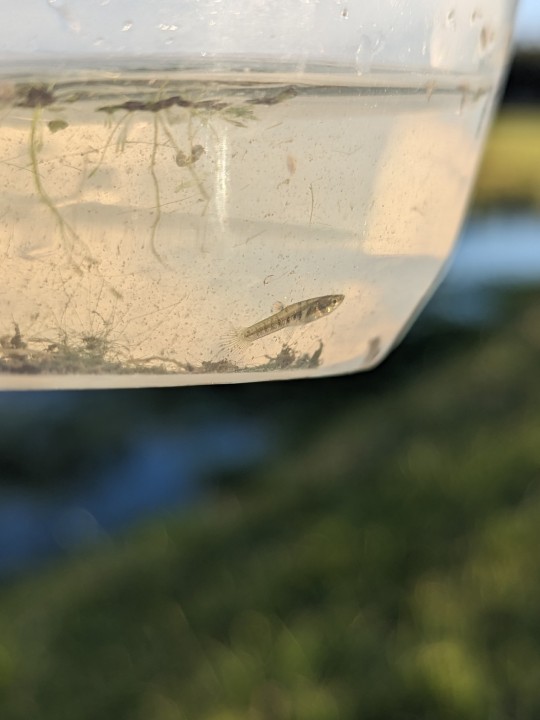
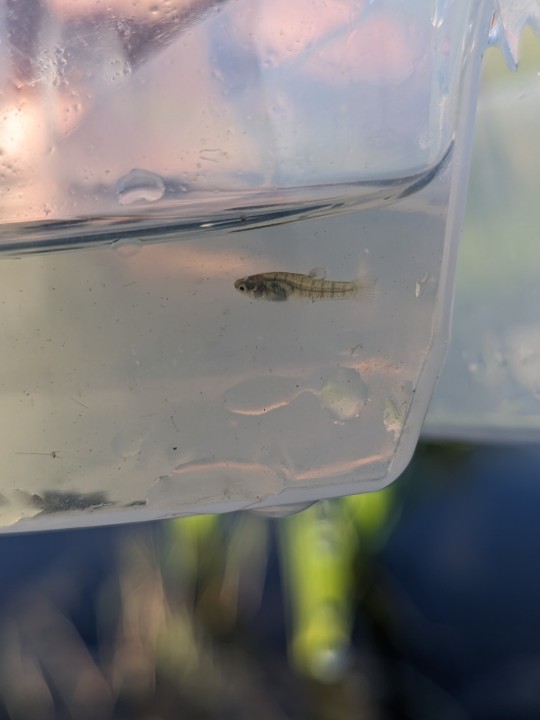
A bunch of softies! I see softshell turtles a lot, butI haven't looked up what species they are yet.

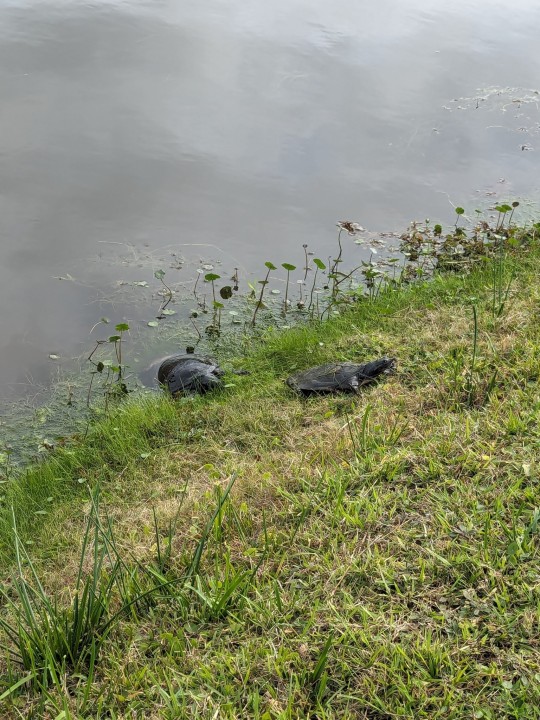
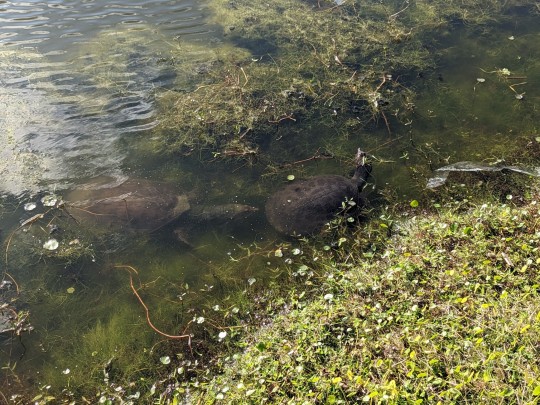
Giant, hella invasive fish! (Plecostomas added a while ago to control algae. They do not) Thankfully, the pond does not directly output to any other bodies of water, even if it floods, and it has a fish fry control grate on the overflow outlet for the grass carp that were recently added.

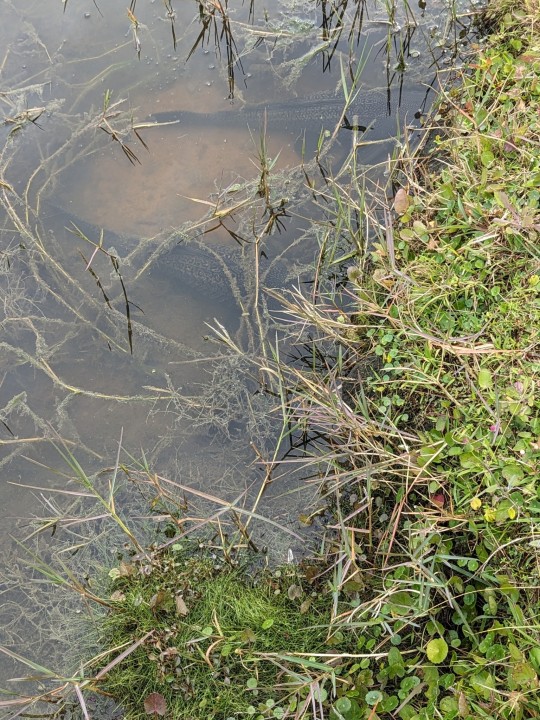

Gators!! Mainly small ones, safely growing bigger away from the adults. I see them basking or floating almost every day. I stumbled on this guy napping while I took a walk.
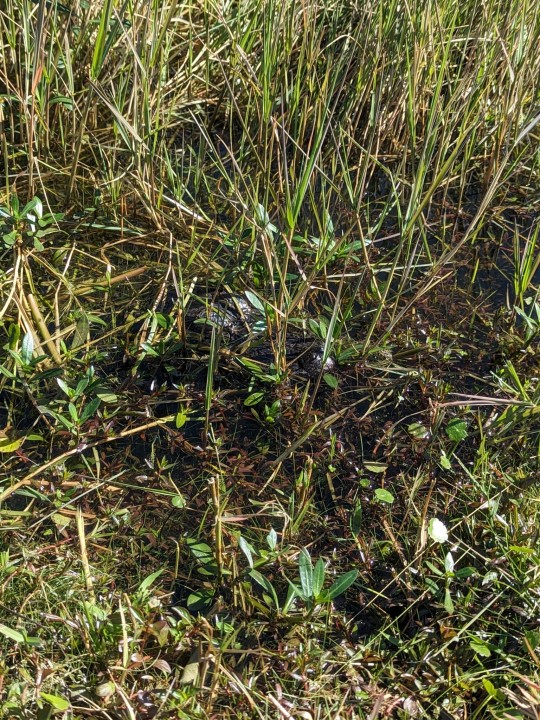
I recently got up enough courage to offer to help take care of the pond, which has an immensely thick layer of muck on the bottom and so little oxygen that the fish hang out in a few shallow channels most of the time.
To my surprise, management happily agreed and is giving me everything I requested to take care of it, including a nice aerator and hundreds of dollars of beneficial bacteria tablets. Even my suggestions to change the landscaping routine and plant native pond plants were enthusiastically accepted.
After being fired from a well paying job because I dared to ask for (completely free, barely visible) disability accommodations, this event is mind blowing to me.
#pond#fish#least killifish#plecostomas#natural pond#fish pond#Florida#nature#softshell turtles#turtles#turtle#described#described images
5 notes
·
View notes
Text
Algae growth is a common problem in bodies of water such as lakes, ponds, and even swimming pools. This not only affects the aesthetic appeal of the water but also threatens the ecosystem. Traditional methods of algae control involve the use of chemicals that can have harmful effects on the environment. However, there is a more sustainable and environmentally friendly solution, which is sonic algae control.
0 notes
Text
Natural Algae Control Methods
A tranquil pond nestled amidst a lush garden is a sight to behold. However, many pond owners are all too familiar with the pesky problem of algae overgrowth. While algae are a natural part of any pond ecosystem, excessive proliferation can disrupt the bal
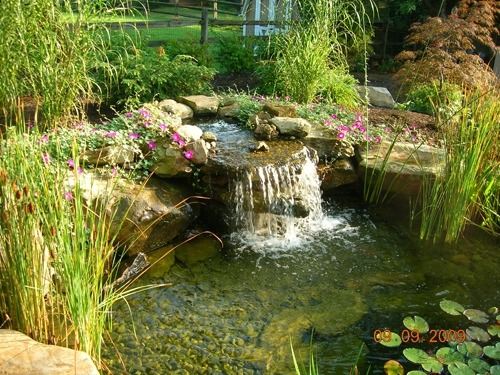
View On WordPress
0 notes
Text
WARTORTLE
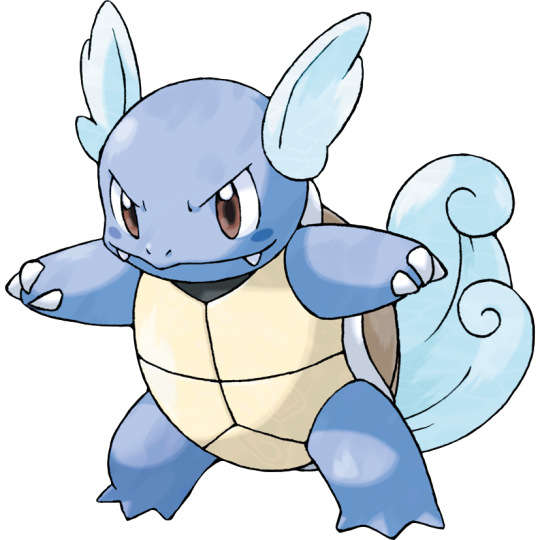
Wartortle is a Water-type turtle Pokemon noteworthy for its furry tail and long lifespan. Wartortle are native to the Pacific Ocean and surrounding coastal areas. Wartortle have the longest confirmed lifespan of any creature.
TAXONOMY
Wartortle are Terrapins or Pond Turtles of the Emydidae family, though their furred fins and tail are unique traits among Terrapins. The name Wartortle is a combination of Warrior and Turtle, as older Wartortle are often covered in scars. Young Wartortle are called Squirtle, though sources differ as to whether this originally meant Squirt Turtle for its tendency to spit water or Squirrel Turtle for its large tail.
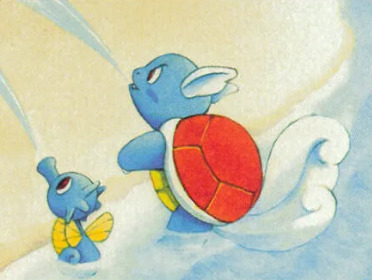
Wartortle and Horsea expelling streams of water
DESCRIPTION
A Wartortle is a bipedal turtle with blue scales, a brown carapace, and a yellow plastron (belly-plate). On their heads they have fins covered in white fur, which resemble ears, and long, furry tails. This fur traps oxygen bubbles, providing additional buoyancy and helping the Wartortle maneuver in the water. The Wartortle can use these trapped bubbles as additional air to allow for extended dives. Algae may grow on a Wartortle’s shell and fur, giving it a green tint. Squirtle hatch with soft shells and without fins or fur, both of which grow in with age. Wartortle store water within their shells, which can be pressurized by specialized internal muscles, and can increase or decrease this pressure to adjust their buoyancy, as well as expel this water from their mouths in a targeted stream, either when threatened or to stun prey.
Wartortle average 1 meter in height with a weight of 22.5 kg.
Wartortle are commonly claimed to live 10,000 years, and no evidence exists of a Wartortle suffering from age-related disease. The longest continually tracked Wartortle was discovered in 1535, making it the oldest confirmed living creature, though there are many unconfirmed claims of older Wartortle. Wartortle heal injuries more efficiently than most other species, though the healing process often leaves scars.
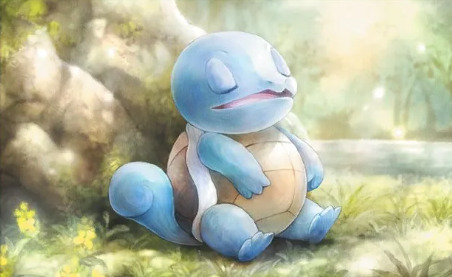
Young Wartortle, called a Squirtle
HABITAT
Wartortle are rarely seen and have large migratory ranges, primarily in the Pacific Ocean and surrounding regions. Wartortle can traverse land and occasionally make homes in freshwater lakes but no individual area has a significant Wartortle population.
BEHAVIOR
Wartortle are omnivores with a primarily vegetarian diet, however, they also consume small animals. Wartortle may hide under the water’s surface to attack creatures that come too close. When threatened, Wartortle withdraw into their shells and expel pressurized water at the attacker. If the shell is cracked, the Wartortle becomes extremely aggressive, biting and striking with its tail. Wartortle do not nest and instead sleep inside their shells. Their controlled buoyancy allows them to sleep on the surface of the ocean.

Trained Wartortle posing
REPRODUCTION
Wartortle only reproduce once every 3-5 years. They lay a clutch of 4-10 eggs, then bury their eggs on land near a body of water. The parents do not remain nearby. When the eggs hatch, the Squirtle must fend entirely for themselves. Most Squirtle do not survive to maturity.
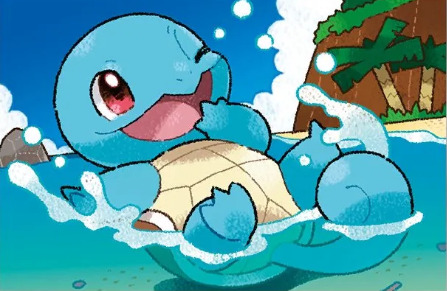
Newly hatched Squirtle often have difficulty controlling themselves in water.
MUTATIONS
When raised by humans, the Wartortle may evolve into the Blastoise (derived from Blast and Tortoise), becoming significantly larger and heavier while losing its fur. Blastoise grow two bone ‘cannons’ from their shell they use to spray water at potentially thousands of PSI. Blastoise are far more powerful and durable than Wartortle but require significantly more food and are neither quick enough nor maneuverable enough to be effective hunters. Blastoise are not normally found in the wild and attempts to reintroduce Blastoise to the wild have been unsuccessful.
Blastoise can further evolve into Mega Blastoise with the Blastoisinite, becoming sturdier, heavier, and growing a larger, more powerful cannon.
In Galar’s Power Spots, some Blastoise have been shown to have a unique Gigantamax transformation where it gains an additional twenty eight cannons. Rather than create rain as other Water-Type Pokemon do at Power Spots, Gigantamax Blastoise unleashes a barrage of pressurized water blasts.
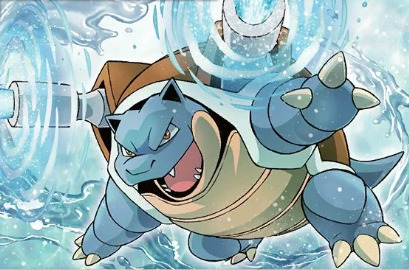
Blastoise can fire water with enough pressure to puncture steel
NOTABLE WARTORTLE
Trainer Red of Pallet Town, leader of Alola’s Battle tree, used a Blastoise in his 1996 Indigo League victory.
“Camila” was captured by Paldean explorers in 1535 and holds the official record for oldest living Pokemon.
“Wakame” is an algae-covered Wartortle with repeated sightings off the coast of the greater Kanto region. The first recorded Wakame sightings occurred between the years 400 and 500, but cannot be proven to be the same Wartortle.
18 notes
·
View notes
Text

Transform Your Yard: The Ultimate Guide to Building a Serene Soaking Pond
The Power of a Soaking Pond
Imagine stepping into your backyard after a long, stressful day. Instead of the usual hustle and bustle, you're greeted by the gentle sound of water cascading over smooth rocks. The air is filled with the soothing scent of nature, and a sense of calm washes over you. This is the magic of a soaking pond—a sanctuary of serenity right in your own yard.
Where to Begin
Selecting the Perfect Spot
Before you grab your shovel and start digging, take some time to carefully choose the location for your soaking pond. Look for an area of your yard that receives partial shade to prevent excessive algae growth and maintain a comfortable water temperature. Additionally, consider the landscape and ensure that the spot you choose complements the overall aesthetics of your outdoor space.
Gathering Your Materials
Building a soaking pond requires a few essential materials, including a pond liner, rocks or gravel, a water pump, and aquatic plants. These elements not only create a beautiful visual but also contribute to the health and balance of your pond ecosystem. Be sure to invest in high-quality materials to ensure the longevity of your pond.
Building Your Soaking Pond
Digging the Foundation
Once you've chosen the perfect location and gathered your materials, it's time to start digging. Use a shovel or excavator to carefully excavate the area, creating a shallow basin for your pond. Aim for a depth of around 18 to 24 inches to ensure ample soaking space without the risk of water overflow.
Installing the Pond Liner
With your foundation dug, it's time to lay down the pond liner. This waterproof barrier will prevent leaks and ensure that your soaking pond retains water effectively. Take care to smooth out any wrinkles or folds in the liner to create a seamless surface.
Adding Natural Elements
Now comes the fun part—adding natural elements to enhance the beauty and functionality of your soaking pond. Start by arranging rocks or gravel along the edges of the pond to create a natural border. These elements not only provide visual interest but also serve as a habitat for beneficial bacteria and aquatic organisms.
Caring for Your Soaking Pond
Water Quality Management
Maintaining pristine water quality is essential for the health and longevity of your soaking pond. Regularly test the water pH and nutrient levels and make adjustments as needed to keep your pond ecosystem in balance. Additionally, consider adding beneficial bacteria and aquatic plants to help filter out impurities and promote a healthy environment.
Algae Control
While a bit of algae is natural in any pond ecosystem, excessive growth can detract from the beauty of your soaking pond. Combat algae blooms by incorporating natural solutions such as barley straw or beneficial bacteria products. Additionally, consider adding shade-loving plants or installing a fountain or waterfall feature to help aerate the water and discourage algae growth.
Embrace Tranquility with a Soaking Pond
In conclusion, building a soaking pond in your yard is a transformative experience that brings peace, tranquility, and natural beauty to your outdoor space. By carefully selecting the perfect location, gathering high-quality materials, and following proper construction and maintenance techniques, you can create a serene oasis that you'll enjoy for years to come.
1. How much space do I need to build a soaking pond?
While the size of your soaking pond can vary depending on your preferences and available space, aim for a minimum depth of 18 to 24 inches and enough surface area to comfortably accommodate multiple people.
2. Do I need to hire a professional to build a soaking pond?
While hiring a professional landscaper or pond builder can streamline the process and ensure optimal results, building a soaking pond is entirely feasible as a DIY project for those with basic construction skills and a willingness to learn.
3. What types of aquatic plants are suitable for a soaking pond?
A variety of aquatic plants can thrive in a soaking pond environment, including water lilies, lotus flowers, iris, and horsetail. Be sure to select species that are well-suited to your climate and water depth to ensure success.
2 notes
·
View notes